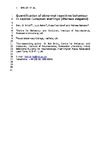Quantification of abnormal repetitive behaviour in captive European starlings (Sturnus vulgaris).
| dc.contributor.author | Brilot, BO | en |
| dc.contributor.author | Asher, L | en |
| dc.contributor.author | Feenders, G | en |
| dc.contributor.author | Bateson, M | en |
| dc.date.accessioned | 2014-05-14T16:23:13Z | |
| dc.date.available | 2014-05-14T16:23:13Z | |
| dc.date.issued | 2009-11 | en |
| dc.identifier.uri | http://hdl.handle.net/10026.1/3020 | |
| dc.description.abstract |
Stereotypies are repetitive, unvarying and goalless behaviour patterns that are often considered indicative of poor welfare in captive animals. Quantifying stereotypies can be difficult, particularly during the early stages of their development when behaviour is still flexible. We compared two methods for objectively quantifying the development of route-tracing stereotypies in caged starlings. We used Markov chains and T-pattern analysis (implemented by the software package, Theme) to identify patterns in the sequence of locations a bird occupied within its cage. Pattern metrics produced by both methods correlated with the frequency of established measures of stereotypic behaviour and abnormal behaviour patterns counted from video recordings, suggesting that both methods could be useful for identifying stereotypic individuals and quantifying stereotypic behaviour. We discuss the relative benefits and disadvantages of the two approaches. | en |
| dc.format.extent | 256 - 264 | en |
| dc.language | eng | en |
| dc.language.iso | eng | en |
| dc.subject | Algorithms | en |
| dc.subject | Animals | en |
| dc.subject | Behavior, Animal | en |
| dc.subject | Discrimination Learning | en |
| dc.subject | Female | en |
| dc.subject | Male | en |
| dc.subject | Markov Chains | en |
| dc.subject | Models, Biological | en |
| dc.subject | Motor Activity | en |
| dc.subject | Regression Analysis | en |
| dc.subject | Starlings | en |
| dc.subject | Stereotyped Behavior | en |
| dc.subject | Video Recording | en |
| dc.title | Quantification of abnormal repetitive behaviour in captive European starlings (Sturnus vulgaris). | en |
| dc.type | Journal Article | |
| plymouth.author-url | https://www.ncbi.nlm.nih.gov/pubmed/19622388 | en |
| plymouth.issue | 3 | en |
| plymouth.volume | 82 | en |
| plymouth.publication-status | Published | en |
| plymouth.journal | Behav Processes | en |
| dc.identifier.doi | 10.1016/j.beproc.2009.07.003 | en |
| plymouth.organisational-group | /Plymouth | |
| plymouth.organisational-group | /Plymouth/Faculty of Science and Engineering | |
| plymouth.organisational-group | /Plymouth/REF 2021 Researchers by UoA | |
| plymouth.organisational-group | /Plymouth/REF 2021 Researchers by UoA/UoA04 Psychology, Psychiatry and Neuroscience | |
| dc.publisher.place | Netherlands | en |
| dcterms.dateAccepted | 2009-07-10 | en |
| dc.identifier.eissn | 1872-8308 | en |
| dc.rights.embargoperiod | Not known | en |
| rioxxterms.versionofrecord | 10.1016/j.beproc.2009.07.003 | en |
| rioxxterms.licenseref.uri | http://www.rioxx.net/licenses/all-rights-reserved | en |
| rioxxterms.licenseref.startdate | 2009-11 | en |
| rioxxterms.type | Journal Article/Review | en |


